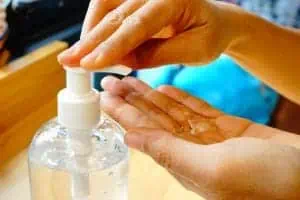 Want to avoid COVID-19 and a host of other contagious illnesses? Killing germs with hand sanitizer when you can’t wash your hands with soap and water is smart. That way, when you touch your face, you transfer far fewer active germs to your eyes, nose or mouth. But with so many hand sanitizers on the market, how do you know which hand sanitizer is the best? Or the best alcohol to look for as an active ingredient? It’s simpler than it seems.
Want to avoid COVID-19 and a host of other contagious illnesses? Killing germs with hand sanitizer when you can’t wash your hands with soap and water is smart. That way, when you touch your face, you transfer far fewer active germs to your eyes, nose or mouth. But with so many hand sanitizers on the market, how do you know which hand sanitizer is the best? Or the best alcohol to look for as an active ingredient? It’s simpler than it seems.
Alcohol content and type
Hand sanitizers with 60% to 95% alcohol are more effective at killing germs than those with a lower percentage of alcohol. (Some manufacturers make hand sanitizers that contain no alcohol, but these products probably aren’t the way to go; they may reduce the growth of germs but won’t necessarily kill germs outright.)
Products with alcohol levels higher than 60% may work faster and may kill more types of germs than 60% alcohol hand sanitizers, but they may also be more irritating to the skin. If your hands get very irritated from hand sanitizer, consider using one with closer to 60% alcohol, said Ted Schiff, MD, founder and chief medical officer of Water’s Edge Dermatology.
“The recommended range is 60% to 90%. There aren’t many studies that show a higher percentage of alcohol makes a hand sanitizer more effective. So, any hand sanitizer used within that range will be effective,” said Dr. Schiff. “However, the gold standard is good hand washing – washing your hands for 20 seconds with soap and warm water. This is always preferred over using hand sanitizer.”
The two types of alcohol the FDA has approved for use in hand sanitizers are ethyl alcohol (also called ethanol) and isopropyl alcohol.
An alternative active ingredient you might see is benzalkonium chloride, which is not an alcohol. It may be less effective against certain viruses and bacteria than alcohol, according to the CDC.
Toxic hand sanitizers to avoid
The FDA warns that some hand sanitizers imported from countries such as Mexico contain methanol, a wood alcohol often used to create fuel and antifreeze. It can be toxic when absorbed through the skin — and life-threatening if ingested. If you see methanol on the product label, steer clear. Because methanol is not always declared on the label, also check the FDA’s do-not-use list of hand sanitizers. The FDA is working to keep these products off U.S. shelves.
Should you make your own?
When there’s a hand sanitizer shortage, you might be tempted to make your own, but the FDA advises against it. According to its website, “If made incorrectly, hand sanitizer can be ineffective, and there have been reports of skin burns from homemade hand sanitizer. The agency lacks verifiable information on the methods being used to prepare hand sanitizer at home and whether they are safe for use on human skin.”
In case you are wondering, vodka doesn’t contain enough alcohol to reliably kill germs.
Tips for using hand sanitizer
Buying an effective hand sanitizer is important, but so is using it correctly. Here are some tips to keep in mind.
- Use enough. The CDC notes that people may not use enough hand sanitizer to fully inactive germs. You need a generous dollop, enough to cover all hand surfaces.
- Let it dry. Apply to one palm, then rub the hand sanitizer over the surfaces of both hands until they’re dry. Wiping off the “excess” may reduce the effectiveness.
- Be thorough. Just as you would with hand-washing, be sure to cover all hand surfaces, including the fingertips, nails, wrists, back of the hands and between the fingers.
- Apply moisturizer immediately after the hand sanitizer dries. If you’re washing your hands and/or using hand sanitizer multiple times a day, your hands may become dry. They may also develop fissures or cracks that let germs penetrate the skin. Moisturizer helps keep the skin intact.
- Wash your hands instead of using hand sanitizer whenever possible. Hand-washing for 20 seconds is not only gentler on your skin than using alcohol-based hand sanitizer, it may also be more effective against certain germs, including norovirus (which causes vomiting and diarrhea), Cryptosporidium (a parasite that causes diarrhea and stomach cramps) and Clostridium difficile (aka C. diff, a bacterium that can cause diarrhea, fever and other symptoms). That said, hand sanitizers can be as effective as hand-washing at reducing certain other germs, including influenza A. If your hands are greasy or visibly dirty, know that hand sanitizer won’t work as well.
- To lower the risk of irritation and dryness, look for a hand sanitizer that contains emollients. “Hand sanitizer that contains an emollient, like aloe, is just as effective as a product without emollients and less drying on your hands,” said Dr. Schiff. “It’s truly about personal preference. My personal preference – and I use a lot of hand sanitizer – is hand sanitizer that does not have emollients because they are unscented and dry faster.”
Hand sanitizer isn’t a magic bullet against all infectious illnesses, but if you buy an effective product and use it properly, it should lower your risk of many of them when you can’t get to soap and water.
“Keeping your hands clean is especially important in the setting of our current pandemic, and hand sanitizer plays an important role,” said Dr. Schiff. But, he adds, “good hand washing is always important as it lessens the spreads of colds, flus and other illnesses.”
Article Written By: Elizabeth Millard, a freelance journalist specializing in health and wellness. Her work has appeared in CNN, Prevention, Runner’s World and Women’s Health. She has also written for Mayo Clinic and Johns Hopkins Health Review.
Medical Review By: Ted Schiff, MD





